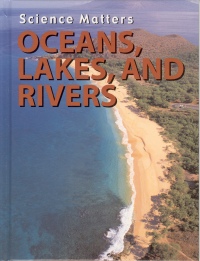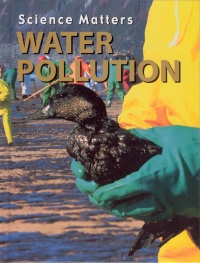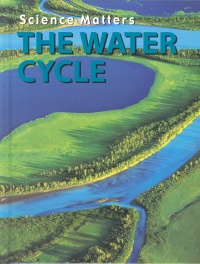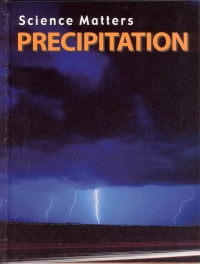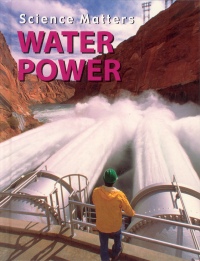| ________________
CM . . .
. Volume XII Number 10 . . . .January 20, 2006
excerpt:
Designed for young readers, these books, part of the 18-volume “Science Matters” series which examines the natural world, focus on forms of water and their impact on the environment. Each title is comprised of 11 chapters, a table of contents, a brief glossary and an index. Several features are similar in each book: a famous person or water-related career is highlighted; experiments reinforcing some of the book’s concepts can be conducted at home with easily obtained materials; there are ideas for surfing the net to obtain further information; fact sheets provide interesting trivia; and a quiz section, entitled “What Have You Learned?” appears at the back of the book. An identical diagram of the water cycle can be found in every volume. The text consists of short sentences using fairly easy vocabulary, while the font is large and simple. Abundant diagrams and fantastic colour photographs- some of them aerial views- make the concepts come alive. Oceans, Lakes and Rivers focuses on the importance of water to the survival of all life forms. Topics include the differences between these bodies of water, salt versus fresh water and protecting water from pollution. Jacques Cousteau, the world-renowned underwater explorer and inventor of S.C.U.B.A., is featured. There is also a section highlighting the scientists who study oceans to predict long-term weather, chart the ocean floor and discover new medicines and foods. Water Pollution discusses the effects of pollution on people and animals. Three main causes of water pollution are given: businesses that dump old machine parts, unused chemicals and garbage into waterways, the farming industry which uses fertilizers and pesticides, and sewage from human and animal wastes. Natural pollutants such as landslides and erosion, which put soil into water, are also mentioned. Other topics include the Exxon Valdez oil spill of 1989 and ideas for preventing water pollution. In The Water Cycle, the three states of water are covered, along with condensation (cloud, dew, fog and frost), transpiration (the process of excess water escaping into the air from the leaves of plants) and evaporation. Types of clouds and forms of precipitation (rain, snow, sleet and hail) show readers the effects of weather. Precipitation examines cloud, fog, snowflake and rainbow formation, flood versus drought and types of storms (blizzards, ice storms and thunderstorms). A list of folklore related to signs of impending rain will amuse readers. A fascinating concept introduced here is cloud seeding which refers to scientists adding chemicals to clouds in order to change them. Some reasons for doing this are to reduce fog around airports so that planes can land safely, to prevent lightning so that the number of forest fires is reduced, and to soften hail so it does less damage to crops. Water Power highlights the creation of electricity and provides a history of water energy use, from water wheels used by the ancient Greeks and Romans to grind wheat and corn, to hydroelectric power and the dams of the present. Being a renewable resource, water is better for producing electricity than is coal, gas, or oil. This book provides a simple explanation of how electricity is created at a power station and lists the advantages and disadvantages of using water power. Eighty per cent of Earth’s fresh water is contained in glaciers, large masses of very slowly moving ice. In Glaciers, there is excellent information about how glaciers are formed, the body of a glacier (which includes the accumulation zone, the upper part where snow piles up; the ablation zone, the lower part where ice, snow and water are lost; and the equilibrium zone, an area in between the others where very little snow or water is added or lost) and how glaciers move. Other topics include the formation of fjords, moraines, kettles, icebergs and erratics (large rocks pulled along by glaciers and deposited elsewhere) by glacial movement. A glaciologist’s work is featured along with facts about the greatest glacier-related dangers- crevasses. In this title, there is an absolutely fabulous photograph of an iceberg shown both above and below the water’s surface. This photo will give readers a clearer idea of an iceberg’s size and the dangers associated with traveling near icebergs. Though the first four titles are fairly basic and straightforward, the most interesting and complex are Water Power and Glaciers. This is a great beginning series for young researchers, but it is a bit pricey, considering that there are only 24 pages in each volume. Recommended. Gail Hamilton is a teacher-librarian in Winnipeg, MB.
To comment
on this title or this review, send mail to cm@umanitoba.ca.
Copyright © the Manitoba Library Association. Reproduction for personal
use is permitted only if this copyright notice is maintained. Any
other reproduction is prohibited without permission.
NEXT REVIEW |
TABLE OF CONTENTS FOR THIS ISSUE
- January 20, 2006.
AUTHORS |
TITLES |
MEDIA REVIEWS |
PROFILES |
BACK ISSUES |
SEARCH |
CMARCHIVE |
HOME |
